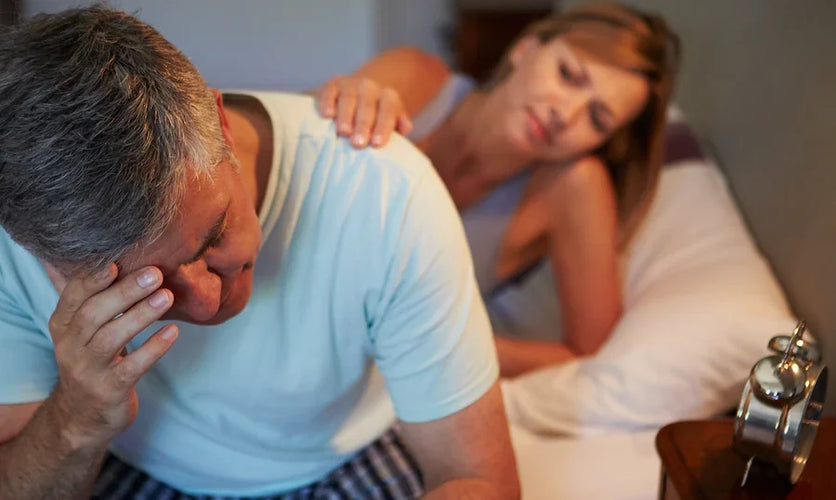LIVING WITH INCONTINENCE
Incontinence exercise
Read moreFREE SHIPPING ON ALL ORDERS!
We’ve added this product to your sample pack
We’ve added this product to your sample pack
Affecting around 30% of men, an overactive bladder can cause incontinence and social isolation. Don’t put up with it. Find out what you can do to improve and manage this debilitating condition.

As the name suggests, an overactive bladder sends messages to be emptied far more frequently than a healthy bladder. Frequency is defined as more than eight times in a 24-hour period, but for some sufferers, it can be as many as 30 times, including during the night. As well as frequency, the urge to urinate is sudden, urgent, and difficult to control, often resulting in involuntary leakage. This is incontinence.
When a healthy bladder is close to capacity, nerves trigger messages to the brain that it needs to be emptied. There’s plenty of time to get to the toilet and adjust clothing. When voiding, the pelvic floor muscles relax and the bladder muscle contracts, pushing the urine out through the urethra. This process is well within your control. An overactive bladder contracts involuntarily, unexpectedly, and well before the bladder has been filled. The ability to ‘hold on’ when the bladder is contracting is extremely difficult, which is why it causes incontinence.
Having to get up more than twice in the night to urinate is also a sign of an overactive bladder in males. Frequent urination at night medically known as nocturia, causes repeated sleep interruptions which are harmful to your physical and mental well-being.
An overactive bladder is also known as an OAB or urge incontinence. It’s a frustrating condition that can interfere with your daily activities like work, social events, sex, and sleep, so don’t put up with it. There are steps you can take to manage, improve, and in some cases, even resolve this overactive bladder in men which is an annoying problem.
Two-thirds of OAB cases in men are caused by an enlarged prostate gland. About 50% of men have an enlarged prostate by the age of 60, and 90% by 85 – so it’s fairly inevitable. The prostate sits at the base of the bladder and the urethra, the tube that takes urine from the bladder to outside the body, runs through it. As the prostate enlarges, it squeezes the urethra, restricting flow and resulting in the bladder failing to entirely empty. Urine left in the bladder can become an irritant, triggering involuntary contractions.
For the other third, causes include:
Never accept an overactive bladder as a normal part of getting older. The underlying condition could be serious and treatable, and the effect on your wellbeing is often underestimated.
The psychological toll of incontinence on men is often greater than women. Females are used to dealing with periods and pads but managing leaks ‘down there’ is unfamiliar to men and often feels like an affront to their masculinity.
Unfortunately, in response to incontinence, some men withdraw from social engagement. The fear of an embarrassing incident stops them from participating in the activities they enjoy, including sport, socialising and outings. Loneliness and isolation are growing problems in modern society, but an overactive bladder shouldn’t contribute to that situation.
There are simple things men can do to feel confident in social situations including wearing highly absorbent, discreet disposable products. These not only keep you dry but prevent any tell-tale odours from developing.
Incontinence can also have a detrimental effect on your sex life, however, there are ways to manage incontinence and sexual intimacy Sex is an essential part of wellbeing so don’t let incontinence get in the way.
The first step in this process is to have the underlying cause diagnosed by your doctor. Once that’s identified, plans to improve the condition can be made.
Treatments of Overactive Bladder might include:
Not all cases of an overactive bladder will resolve, even if there is an improvement. Further, some treatments may take time, so management will be necessary. This typically involves choosing an absorbent product that best suits your needs, and TENA has a range specifically designed for men.
An overactive bladder usually results in the entire bladder unexpectedly voiding before you can get to the bathroom, so TENA Men Active Fit Pants are an ideal choice. Designed to look and feel like regular underwear, these navy briefs rapidly absorb large quantities of liquid, locking it deep inside the pants to keep you dry, comfortable and odour-free. If you need a longer-lasting product to absorb several voids, try TENA Pants Level 4 for maximum absorbency. Both products are unnoticeable under dress pants, jeans and even shorts.
For very small dribbles that might catch you out before or after you get to a bathroom, TENA Protective Shield tucks snuggly into the front of your regular briefs to catch those drips. TENA Shield is easy to wear and so thin, you’ll barely notice it’s there.
Have a look at the full range of TENA products for men to decide what might be best to manage your overactive bladder.
Sources:
Asaleo Care makes no warranties or representations regarding the completeness or accuracy of the information. This information should be used only as a guide and should not be relied upon as a substitute for professional, medical or other health professional advice